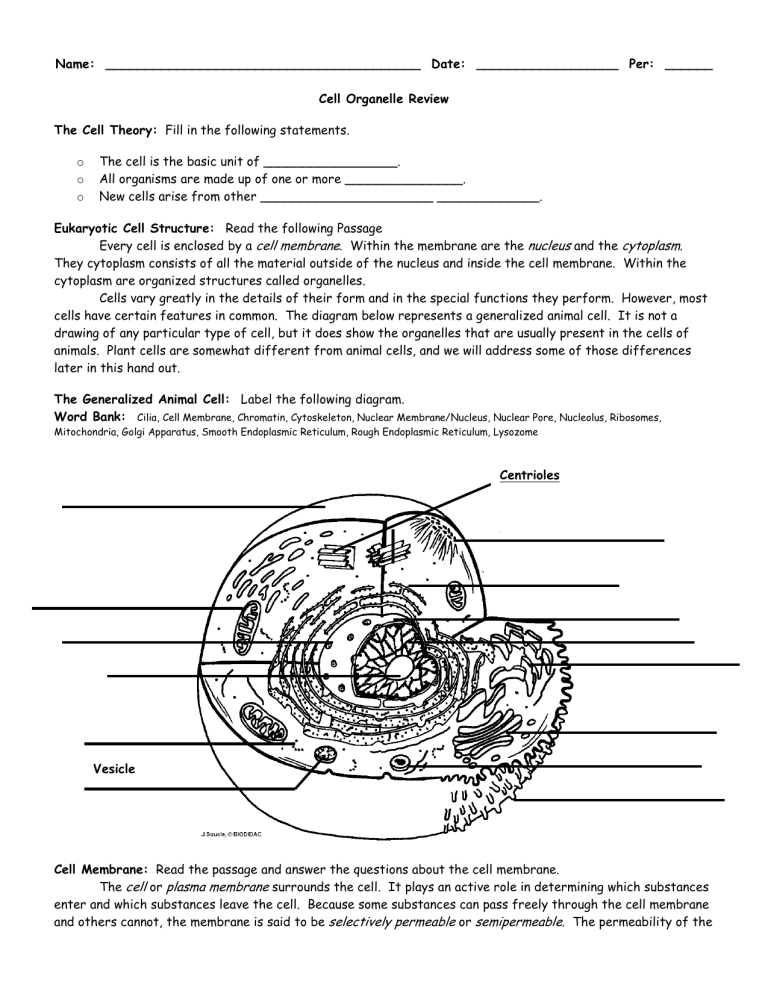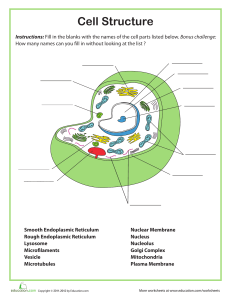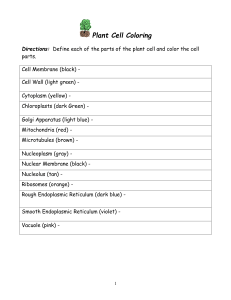
Name: ________________________________________ Date: __________________ Per: ______ Cell Organelle Review The Cell Theory: Fill in the following statements. o o o The cell is the basic unit of _________________. All organisms are made up of one or more _______________. New cells arise from other ______________________ _____________. Eukaryotic Cell Structure: Read the following Passage Every cell is enclosed by a cell membrane. Within the membrane are the nucleus and the cytoplasm. They cytoplasm consists of all the material outside of the nucleus and inside the cell membrane. Within the cytoplasm are organized structures called organelles. Cells vary greatly in the details of their form and in the special functions they perform. However, most cells have certain features in common. The diagram below represents a generalized animal cell. It is not a drawing of any particular type of cell, but it does show the organelles that are usually present in the cells of animals. Plant cells are somewhat different from animal cells, and we will address some of those differences later in this hand out. The Generalized Animal Cell: Label the following diagram. Word Bank: Cilia, Cell Membrane, Chromatin, Cytoskeleton, Nuclear Membrane/Nucleus, Nuclear Pore, Nucleolus, Ribosomes, Mitochondria, Golgi Apparatus, Smooth Endoplasmic Reticulum, Rough Endoplasmic Reticulum, Lysozome Centrioles Vesicle Cell Membrane: Read the passage and answer the questions about the cell membrane. The cell or plasma membrane surrounds the cell. It plays an active role in determining which substances enter and which substances leave the cell. Because some substances can pass freely through the cell membrane and others cannot, the membrane is said to be selectively permeable or semipermeable. The permeability of the plasma membrane varies from one cell type to another and from time to time in the same type of cell depending on its metabolic activity. The cell membrane is primarily composed of lipid and proteins. The lipids are called phosphoplipids and they form a double layer of lipid called a lipid bilayer. The hydrophilic, polar phosphate heads of these molecules face outside and inside of the cell while the hydrophobic, nonpolar lipid tails face inward. Protein molecules are either embedded into the lipid and extend through to both sides or they sit on the surface of the inner or outer portions of the membrane. Proteins function to transport materials in or out of the cell, adhere cells to one another, or communicate with molecules that want to enter or leave the cell. Transport of materials into and out of the cell is regulated by proteins in the cell membrane. Certain molecules that are small and nonpolar can move through the membrane along their concentration gradients. This process is called diffusion. Movement of water across a membrane on its concentration gradient is a type of diffusion called osmosis. Both of these transport mechanisms are examples of passive transport because they do not pose an energy cost to the cell. Other large materials or ions may be taken in by active transport, and these methods (endocytosis, exocytosis, and ion pumps) occur against a concentration gradient and with an energy cost. 1. 2. 3. 4. 5. 6. Describe 2 functions of the cell membrane: ______________________________________________________________________________ ______________________________________________________________________________ ______________________________________________________________________________ The cell membrane is primarily composed of ____________________ and ____________________. Protein molecules are either __________________________ in the lipid or _____________ on the surface of membrane. Why is the cell membrane described as “semipermeable”? ______________________________________________________________________________ ______________________________________________________________________________ Small, non polar materials may move across cell membranes by a process called __________________. ___________________ transport occurs with a concentration gradient and at no energy cost to a cell while _____________________ transport costs a cell energy to carry out. Cytoplasm: Read the passage and answer the questions about the cytoplasm. The material in the cell but outside the nucleus is called the cytoplasm. Although it contains thousands of substances, the cytoplasm consists mainly of water. Within in the cytoplasm are the various organelles of the cell. The cytoplasm provides the environment in which the organelles carry on the life processes for the cell. 1. What is the main function of the cytoplasm? ______________________________________________________________________________ ______________________________________________________________________________ 2. The cytoplasm consists mainly of ________________. Nucleus: Read the passage and answer the questions about the nucleus. The nucleus is the control center for cell functions. It is surrounded by its own semipermeable membrane which has nuclear pores to allow materials to pass through. Within the nucleus are the chromatin threads and at least one nucleolus. Nucleoli are involved in the production of ribosomes. 1. The control center of the cell is the __________________. 2. The ____________________ is involved in the production of ribosomes. 3. During cell division, chromatin threads coil into tightly packed DNA pieces called ________________. Endoplasmic Reticulum: Read the passage and answer the questions about the ER. The endoplasmic reticulum is a membrane-bound system of fluid filled channels or tubes through which materials are transported inside a cell. The membranes of the endoplasmic reticulum may also serve as sites of biochemical reactions. There are two types of endoplasmic reticulum – smooth and rough. The rough appearance of some endoplasmic reticulum is due to the presence of ribosomes on the surface of the endoplasmic reticulum membranes. Ribosomes on the rough endoplasmic reticulum aid in production of proteins that will be exported from the cell. Proteins made here move from the endoplasmic reticulum to the Golgi apparatus where they are packaged and sent out of the cell membrane by exocytosis. Smooth endoplasmic reticulum has no ribosomes on its membranes, and it is important for synthesis of lipids for organelle membranes and transport vesicles. Smooth endoplasmic reticulum also aids a cell in breakdown of accumulated toxins. 1. What are the functions of the endoplasmic reticulum? ______________________________________________________________________________ ______________________________________________________________________________ ______________________________________________________________________________ 2. The two types of endoplasmic reticulum are the ___________________ and the ________________. 3. What is significant about proteins produced by ribosomes on the rough endoplasmic reticulum? ______________________________________________________________________________ Golgi Bodies: Read the passage and answer the questions about the Golgi body/apparatus. A Golgi body is made up of a series of membrane-enclosed sacs. It is usually found near the nucleus. This organelle is associated with the packaging and processing of cell products to be secreted by the cell. As portions of the endoplasmic reticulum become filled with products, small sections break off forming small spherical sacs called vesicles. The vesicles become a part of a Golgi body’s complex or membranes. The vesicles eventually move toward the cell membrane and release their products outside of the cell. 1. What is the role of the Golgi apparatus? ______________________________________________________________________________ ______________________________________________________________________________ Mitochondria: Read the passage and answer the questions about the mitochondria. Mitochondria are slipper-shaped organelles found in the cytoplasm of animal and plant cells. They are enclosed by a membrane, and they also have a highly folded inner membrane with a large surface area. Aerobic cellular respiration occurs in the mitochondria, and the folded inner membrane is the site of the electron transport chain where ATP synthesis takes place. 1. What is the overall function of the mitochondria? ______________________________________________________________________________ 2. What is ATP? ______________________________________________________________________________ ______________________________________________________________________________ The Generalized Plant Cell: Read the passage and answer the questions about plant cells. Plant cells are eukaryotic cells that are specialized for an autotrophic lifestyle. Plant cells contain almost all of the same organelles as animal cells, but they have additional specialized structures including a cell wall, a central vacuole, and chloroplasts. Chloroplasts are where photosynthesis takes place. Photosynthesis consists of a light dependent portion where energy is captured and a light independent process – the Calvin Cycle – where energy is used to fix carbon dioxide gas into usable carbohydrates. 1. What are three structural differences between a typical animal cell and a typical green plant cell? ______________________________________________________________________________ ______________________________________________________________________________ 2. What is the role of the chloroplast? ______________________________________________________________________________ 3. Organisms that make their own food are classified as ________________________ while those that must consume others for nutrients are called ______________________________. Cell Walls: Read the passage and answer the questions about cell walls. The cell wall is a structure found just outside the cell membrane in plant cells. It is considered to be a nonliving part of the cell since it does not take place in any of the life functions of the cell. The cell wall is made up chiefly of cellulose, is relatively rigid, and provided general protection as well as protection from water loss to the cell. 1. What are the functions of the cell wall? ______________________________________________________________________________ ______________________________________________________________________________ 2. The cell wall is primarily composed of _________________________. Vacuoles: Read the passage and answer the questions about vacuoles. Vacuoles are membrane enclosed structures that are generally filled with water containing various dissolved substances. Large, central vacuoles are generally present in plant cells. The pressure created by the central vacuole as it fills with water helps to maintain the rigid structure of the plant cell and of the plant. Some animal cells may have smaller vacuoles called food vacuoles or contractile vacuoles. These are basically lipid bound vesicles and serve special needs for organisms in challenging environments. In simple organisms like the amoeba, the food vacuole is a chamber where large food molecules are digested for use by the cell. In some fresh water protozoa like the paramecium, there are contractile vacuoles that remove excess water from the cell and discharge it back into the environment. Often the discharge of water results in movement of the cell. 1. What is the function of the large, central vacuole in green plants? ______________________________________________________________________________ ______________________________________________________________________________ 2. In simple organisms like the amoeba, digestion occurs within the __________ _________________. 3. How is excess water removed from freshwater organisms like the paramecium? ______________________________________________________________________________ ______________________________________________________________________________





